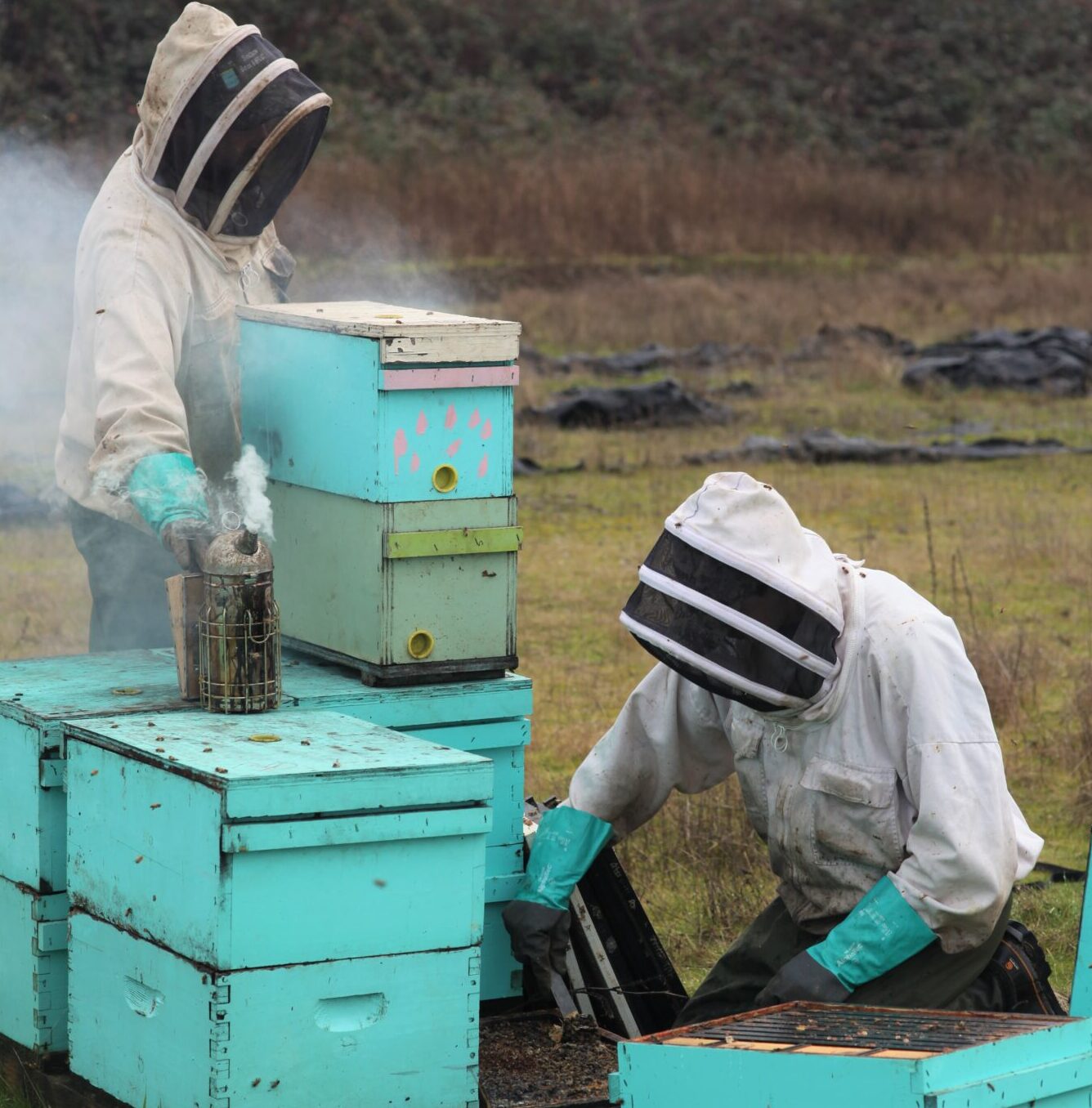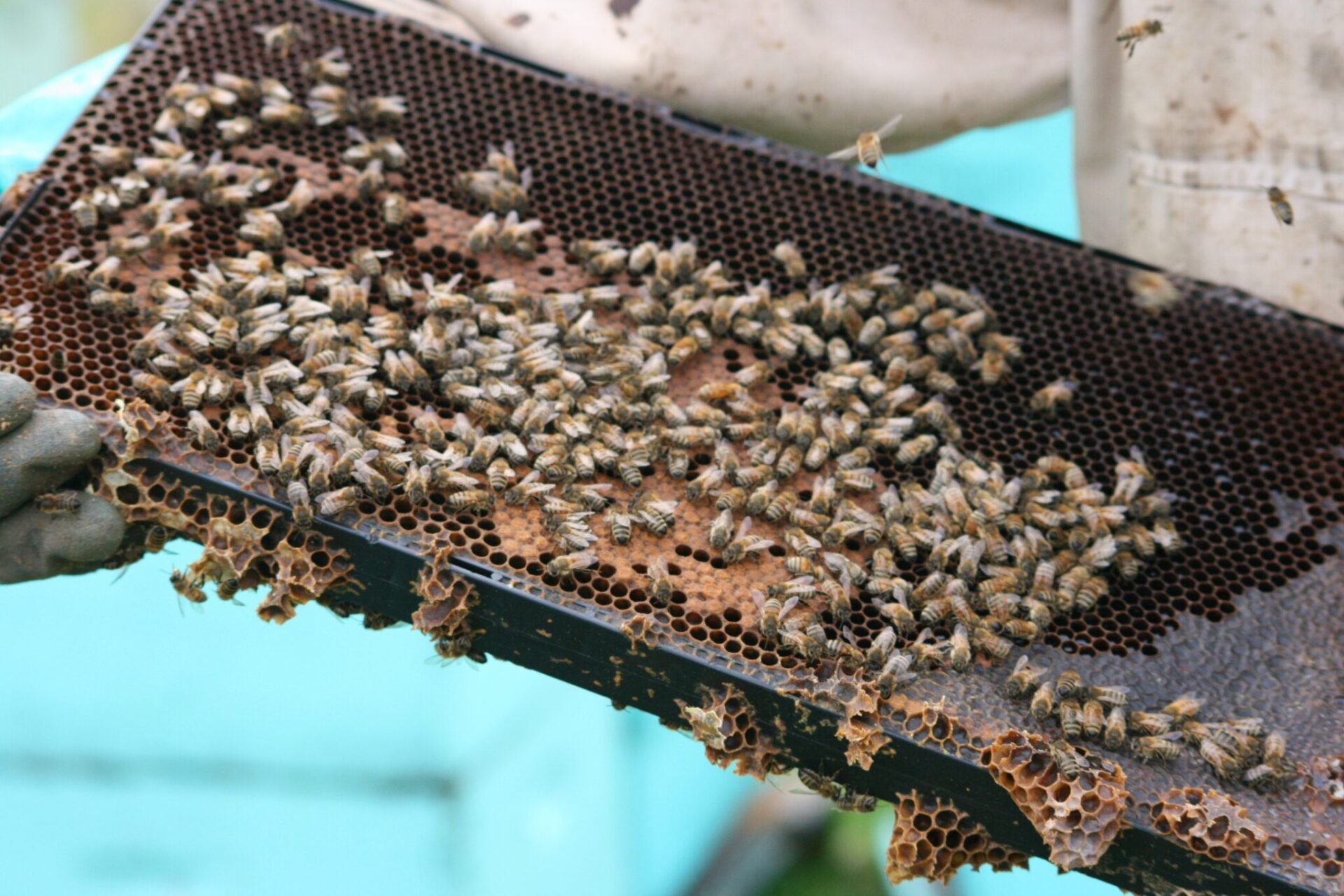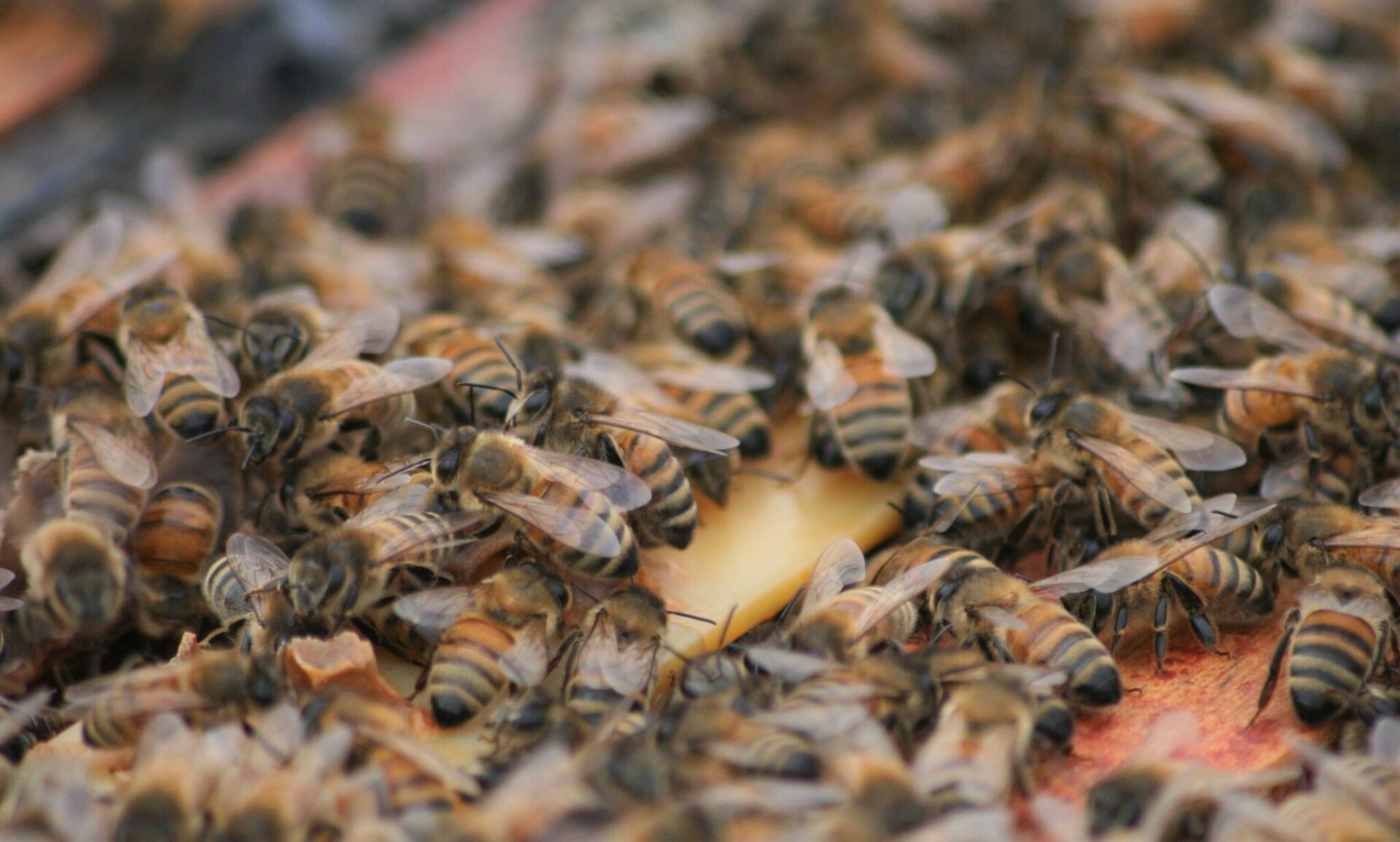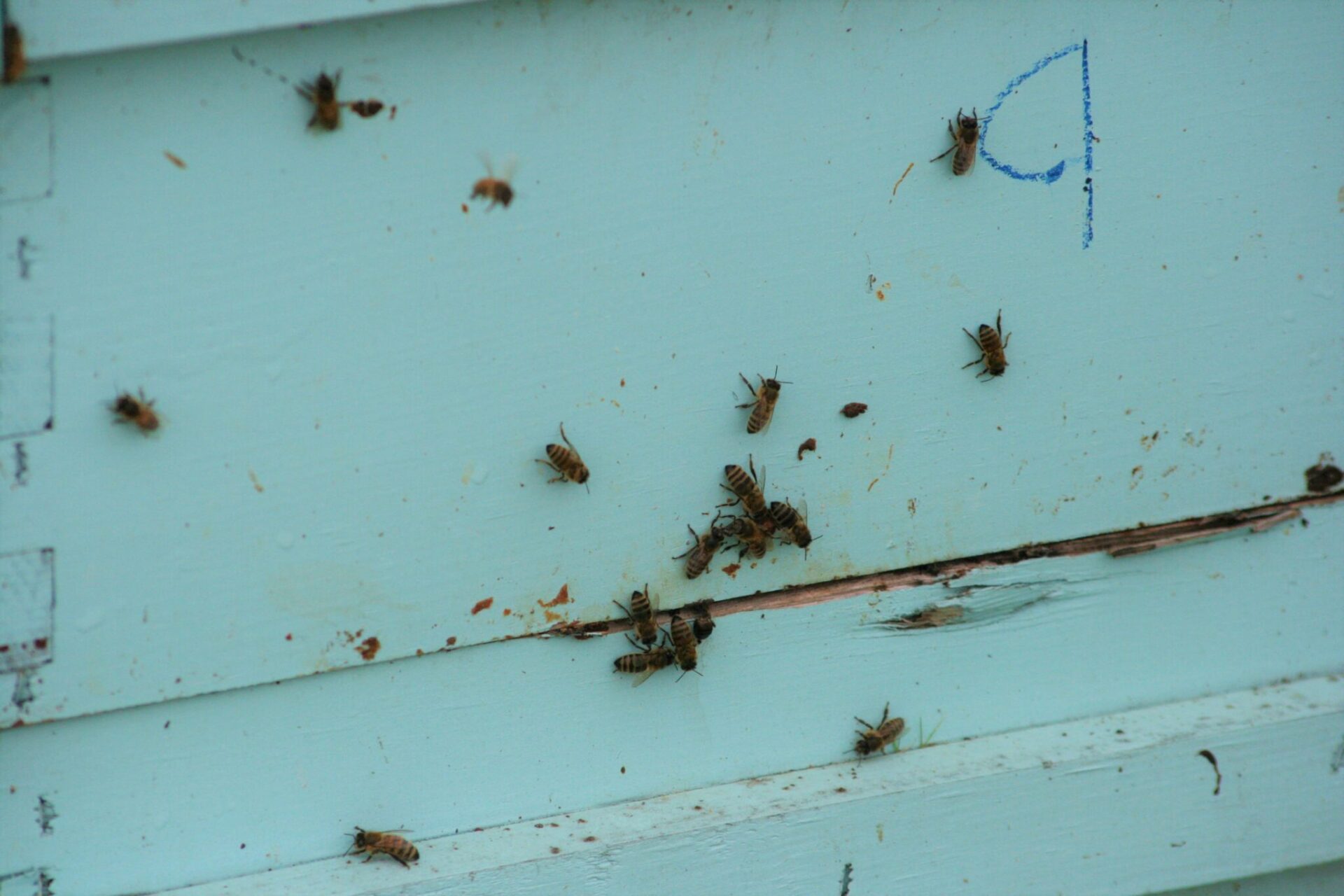
Around Christmastime, Aaron Lafond and his son Felix of Southpaw Bees and Manufacturing LLC in Lebanon, Ore. start splitting their honeybee hives. Once split— the top 10 frames removed from the bottom 10 frames— they check the health of the hives and feed the bees.
The long, flat pollen patties that they place on top of the bee frames is a nutritious food source that not only feeds the bees but stimulates them and convinces the queens it’s time to start laying vast quantities of eggs. Without the additional food, the queen wouldn’t start laying eggs in earnest for another several weeks. The bees may not have realized it yet, but Lafond’s queens and their worker bees are gearing up for the biggest pollination event in the world—the California almond bloom. Honeybees, of course, play a critical role in almond pollination.
Sending the Hives
Only around 500,000 honeybee hives reside fulltime in California. Since it takes approximately 2 million hives to pollinate the 1.2-million acres of almonds in the state, beekeepers and their hives travel far and wide to assist – some from as far away as the east coast.
Before shipping 1,800 of his hives to California, Lafond does a preliminary grading of hive size in his bee yards. The yards are scattered around Oregon’s Mid-Willamette Valley. A vigorous colony contains around 20,000 to 80,000 honeybees. The Lafonds take frames of healthy, active bees out of half-sized nucleus hives and add them to the full-sized hives as needed. Lafond’s contracts with almond growers call for an eight-frame average with a five-frame minimum.
“That’s standard in the industry,” Lafond said.
Lafond splits his hives among five California almond growers outside of the Chico area. The size of those growers’ orchards range in size from 20 acres to nearly 700 acres. The largest grower alone leases 1,000 hives from Lafond. Since Lafond has held the same contracts for years, he doesn’t need to use a broker.
The bees are shipped the 425 miles on an open semi-trailer with netting covering the hives.
“We could probably ship them without netting, but Shasta County requires it,” Lafond said.
Like the bees, once the hives arrive in Butte County, Lafond’s work is just beginning. Lafond, his wife Beth and their three teenage children follow the bees. They haul their travel trailer to stay in, along with the bee equipment needed to unload and care for the bees. Equipment includes a Hummerbee articulated forklift, which is specially manufactured for beekeepers.
The Lafonds spend two weeks in California getting the bees settled into the various orchards. They’ll return home to Oregon for a couple of weeks, only to turn around and head back to the Sacramento Valley again at the end of February for peak almond bloom.
During the last two days in February, Lafond starts raising his own queens. He genetically chooses larvae from hives with good health and honey-making prowess. Lafond carefully removes a grub-like white larva one at a time with a metal tool that resembles a long, thin crochet hook. He grafts the larva into small, plastic cell cups and hangs several cups from a frame inside a queen-less hive. Because there is no queen, and because the queen cells are hanging from the frames in a similar way that bees hang their own queen cells, the worker bees feed the larvae royal jelly, which turns them into queens.
Lafond pulls the queen cells out before they hatch. Honeybees only allow one queen to live in each colony and will kill the others. He uses the new queens to start his new nucleus hives, known as nucs. Unlike the standard 20-frame full-size hive (18 frames of bees with two feeder trays), a nuc is half the size – double story with five frames in each story. When there is die-out in hives, Lafond pulls frames of bees – each has around 1,700 adult bees caring for the larvae inside – from the nucs to add strength and numbers to weakened full-size hives.

Honeybee Health
As far as weakened hives, or hive die-out, Varroa mites, V. destructor, are the biggest issue for beekeepers and are usually to blame. Like honeybees, which are of European descent, the Varroa mites aren’t native to the United States. Varroa mites likely came from Australia. The mites are a vector for at least five different incapacitating bee viruses, including varroosis, otherwise known as deformed wing virus.
“They are born without wings or with wings that are messed up,” Lafond said.
Varroosis and acute bee paralysis virus (ABPV) are the two biggest issues Lafond has with his bees. ABPV causes the bees to tremble with sprawling legs and wings. Infected bees show symptoms within two to four days and die within a day after that.
Varroa mites can only reproduce in a honeybee colony. They live in the hives and on the bees. The male mites are white. The females, which are the real problem, are reddish-brown and can be easily spotted on honeybees.
“It’s like if a human had a volleyball stuck to their head,” Lafond said about the size of mites in comparison to the size of bees.
The mites attach themselves between the platelets of bees and feed on their fat, weakening the bees or even killing them. Open wounds caused by the parasitic mites become sites for disease to enter.
It takes 21 days from egg-laying to emergence of an adult worker bee. Once a brood cell is capped, it will hatch in ten days. In the first 11 days, the larvae emit pheromones that signal the worker bees to feed them. When they’ve had enough to eat, the larvae release different pheromones that tell the workers it’s time to cap the brood cells. Mites also understand the pheromone change and react by entering the cells before they are capped. Inside the cells, the mites lay eggs and feed on the bee larvae.
“Mites chew on them and shorten the bee’s lives. Then, the mites live in the hive and on the bees,” Lafond said. “There’s always losses that you have to deal with. 20% to 30% is standard loss. This year, we had 22% loss in the winter and 8% in the fall. Mites are here to stay.”
Other issues that have affected Lafond’s bees includes theft, vandalism and wildfires, although on a much smaller scale than mites.
“I believe that the smoke from the fires did suppress brood some,” Lafond’s wife Beth said about the 2020 western wildfires.
As for theft and vandalism, Beth said, “We have had a few hives stolen in California over the years, but not very many. We have had feed jugs stolen in Albany (Oregon) but no hives stolen. We’ve had hives shot up and ran over a few times in the (Willamette) valley.”

Spray Carefully
Lafond said the almond growers he works with are careful with sprays around the bees. If they have to spray, they do it at night when the bees are in their hives. He did have die-out once from fungicide sprayed during the day.
“The growers we work with try extremely hard not to spray fungicides near the bees,” Lafond said.
He noted that helicopter spraying could be an issue since it is only done during the day. But the growers he works with don’t utilize aerial spraying.
“It’s one of those give and takes. It’s farming,” said Lafond, adding, “It shouldn’t necessarily be at the expense of bees.”
Honey Season
Almond blossoms don’t make a whole lot of honey, Lafond said. What almond honey the bees do make tastes slightly bitter to humans. During the first week in April after the almond petals drop, Lafond will ship his bees back to Oregon. He’ll lease out his hives to pollinate Willamette Valley crops such as blueberries, radish, clovers, Chinese cabbage, sun flowers, spinach, coriander, meadowfoam, blackberries and turnips. Turnip honey crystalizes in the hives. Meadowfoam makes sweet honey. But wild blackberries are the main honey crop in Oregon.
“We set the bees in areas with a lot of wild blackberries. They produce two times more honey than any other crop,” Lafond said.
It takes the Lafond family three weeks from mid-July to August to pull all of the special honey boxes, called supers. They get around 85 barrels of honey a year. Beth sells honey and bees wax wholesale. She also bottles wildflower, blackberry and meadowfoam honey and sells it retail at their farm.
After pollination and honey season, Lafond, who has a background in cabinetry, catches up on orders for bee boxes, pallets, tops and bottoms in his wood shop. His family helps him build 500 to 1,000 bee boxes a year for himself and 4,000 to 5,000 for other beekeepers.











